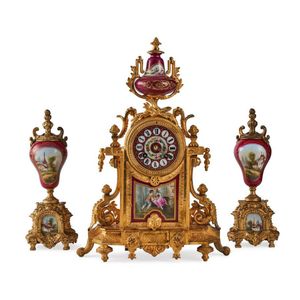Sevres Style Clock Garnitures with Ormolu Mounts
You must be a subscriber, and be logged in to view price and dealer details.
Subscribe Now to view actual auction price for this item
When you subscribe, you have the option of setting the currency in which to display prices to $Au, $US, $NZ or Stg.
- Pendulum - The pendulum was discovered around 1602 by Galileo Galilei, and was adopted for time keeping by the Dutch mathematician and natural philosopher, Christiaan Huygens, who excelled in astronomy, physics, and horology.
The pendulum comprises a metal rod usually of brass or steel with a metal disk, known as a bob, at the end. The movement of the pendulum is driven by weights or a spring, and as a pendulum swings in a regular arc, it was found accuracy could be controlled to within a few seconds a week.
Timekeeping can be adjusted by changing the height of the bob on the rod, making the pendulum either swing slower or faster.
The disadvantage of the pendulum was that changes in temperature also changed the length of the pendulum, interfering with the accuracy of the clock, and so in the 18th century two types of mercurial pendulums were invented which countered the movement in the steel rod.
The pendulum was the world's most accurate timekeeping technology until the invention of the quartz clock, regulated by a quartz crystal, in 1927. - Ormolu - Ormolu was popular with French craftsmen in the 18th and 19th century for ornamental fittings for furniture, clocks and other decorative items. True ormolu is gilt bronze, that is bronze that has been coated with gold using a mercury amalgam. Due to the health risks associated with using mercury, this method of creating ormolu was discontinued in France in the 1830s. A substitute was developed consisting of about 75% copper and 25% zinc, however it was inferior to the bronze version. It was often lacquered to prevent it tarnishing.
This item has been included into following indexes:
Visually similar items

Late 19th century French ormolu clock garniture

French Sevres style mantle clock gilt metal mount, with porcelain panels decorated with coastal scene, flowers and insects. Height 37 cm width 24 cm depth 12 cm

A French porcelain and gilt clock garniture set late 19th century the clock and urns stamped P.H. Mourey, comprising of a clock (AF), a pair of urns and a pair candlesticks the urns have reversible tops that can be used as candle snuffers height 34 cm

A fine Sevres and gilt bronze clock in the Louis XV manner, 19th century, with maker's mark LG, the finely cast clock with a central bleu celeste porcelain urn with a painted flower roundel flanked by pierced trailing floral garlands to a richly scrolled r
